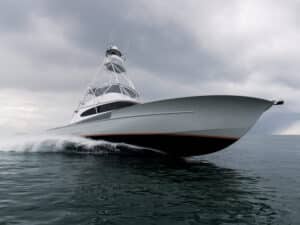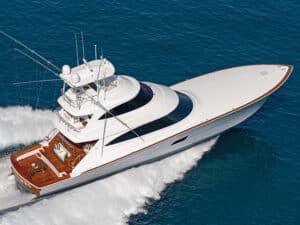
I’m sure you’ve seen a commercial like this: The camera focuses on a well-dressed gentleman who exits a building and walks to a shiny luxury vehicle. In the background, workmen break up pavement with jackhammers. The ambient noise hits the pain threshold. The gentleman opens the car door, sits in the driver’s seat and closes the door. All noise ceases, replaced by overwhelming quiet. Pulling back, the camera sees the luxury vehicle drive away through large potholes. The camera pans to wheels bouncing dramatically with each bump and hole in the road. Cut to driver. Soft classical music playing and no noticeable transfer of road surface to vehicle interior.
That’s exactly the feeling I get climbing into the enclosed flybridge on the new Hatteras 65 while running out Palm Beach Inlet in a stiff southeast wind against the tide. You see the spray and feel the boat moving, but all apparently from a soundproof booth. For all those (like me) who claim to prefer an open bridge, one trip in really nasty weather will convince you of the efficacy of an enclosed bridge.
Performance
In reasonable seas, normal cruising speed proved to be about 28 knots at 1,900 rpm using 112 gph. Top speed touched 35 knots at 2,360 rpm – faster than any Hatteras 65 I’ve ever run.
We ran the speed tests in a 5-foot beam sea first thing in the morning, but winds increased to 20 knots, and seas were running 8 to 10 feet by the time we headed home. Running south with the wind and seas from the southeast required us to drop back speed to 18 to 20 knots. This is when an enclosed bridge truly shines! We plowed through, taking it virtually on the nose for 30 miles back to Palm Beach with absolute impunity.
Fishability
Working our way north, up Sailfish Alley, we stopped and fished whenever we found bait on the fish finder. But it wasn’t until we reached Stuart, Florida, that we found the hot sailfish bite. We first flew kites, with the kite rods on the flybridge. But the current ran so strong, we ended up joining the fleet in slow-trolling our live goggle-eyes and threadfin herring. Either way, the 65 proved steady as a rock, whether heading down, up or beam-to the seas. I can’t imagine a boat being more comfortable sitting in a trough while live baiting.
**
Cockpit**
As you’d expect from a 65-foot boat, the huge cockpit provides more than enough space for a whole team of anglers and mates to work simultaneously. The cockpit gunwale, situated 3 feet above the waterline, means reviving a fish is a bit of a stretch, but it’s doable.
A large baitwell in the transom can double as a fish box if you aren’t fishing live bait. In the deck, a split hatch hides a very large athwartship fish box. Augmenting the fighting chair or rocket launcher, you’ll find storage space for two rods in each gunwale and three more in each cabin coaming.
My pet peeve on large sport-fishing boats has to be dead space. There’s no need for a portable cooler in the cockpit of any boat over 35 or 40 feet. For that reason, I’d like to see an integrated drink cooler in this 65’s cockpit. It would be easy enough to put one under the steps.
One thing common to fishing sailfish in prime conditions at Sailfish Alley is getting wet when backing down into the big seas. Sure, you try to avoid it, but sometimes you just can’t. Fortunately, the 65 has a terrific scupper system. Despite seas occasionally coming over the caprail, water never covered the cockpit sole. Side exhausts also help keep the cockpit quiet and cut down on exhaust fumes coming back into the cockpit.
Flybridge
You won’t likely run out of space for guests on this flybridge, thanks to long settees on each side in addition to the two comfortable Pompanette helm chairs. Whether you’re entertaining or not, an icemaker and a refrigerator assure refreshments are never out of reach. Every creature comfort has been thought of on this bridge, right down to the settee’s beautiful pullout wooden footrests.
Since you can’t see the cockpit from the enclosed flybridge, Hatteras puts a remote helm station outside on the aft end of the bridge for driving while fighting fish or docking. It’s one of the small sacrifices required by all enclosed flybridge fishing boats.
**
Interior**
As you’d expect on a boat such as this, the interior can be customized. Most owners will select a three-sided settee for the portside so several people can sleep there on the way to the fishing grounds. Having tried it out, I assure you that the salon boasts an extremely comfortable noise level, with the most prominent sound under way being the muted turbo whistle. I also appreciate the fact that Hatteras placed the entertainment center and TV on the aft end of the salon for better privacy when sitting at the dock.
Hatteras joiner work has never been better, showcasing a high-gloss finish on all wood. (Our test boat was optional cherry. Maple comes standard.) The 65 also provides indirect and aircraft lighting absolutely everywhere, offering superb illumination.
Galley counters capped in marble form almost a 360-degree enclosure, but being only waist-high, they never cut the chef off from the rest of the guests. The counters also work exceptionally well for presenting hors d’oeuvres and buffets. A four-burner electric cooktop, along with convection/microwave oven, makes gourmet cooking quick and fuss-free. Another interesting feature is that the sink is positioned along the portside. I’d never considered it before, but I discovered I really like being able to work at the sink washing dishes while looking out the huge side window.
Belowdecks, Hatteras offers one four-cabin and two three-cabin configurations. The four-stateroom model has two over/under berth cabins to starboard, a double in the bow and an oblique double to port. Both three-stateroom layouts provide only one over/under amidships (under the dinette). All provide access through the midcabin to a utility room with pumps and air-conditioning units. Future models should have a transverse bulkhead door through to the engine room as well.
Our test boat provided flybridge access only from the cockpit, but you can order access from the salon if you wish. It will take some of the unusually comfortable apostrophe-shaped dinette space to do it, though. About the only change I’d like to see in the salon is to affix a long, overhead handhold running from the cockpit door to the stateroom stairway for safety.
Engine Room
Cresting at well over 6 feet tall, I can really appreciate a big engine room. Not only does this 65 have a well-laid-out space, but also I can stand upright with room to spare. Hatterascal had been fitted with big iron – a pair of 16-cylinder MTUs (1,800 hp each) representing close to a $300,000 upgrade over the standard CAT 12-cylinder diesels of 1,400 hp each.
Of course, all valves and maintenance points can be easily accessed on or near centerline, and generators sit on the aft end of the compartment to keep them away from living quarters.
It’s obvious that Hatteras wants you to be able to keep track of conditions in the engine compartment. The Hatterascal had engine control panels on the aft end so you can easily peek at them as soon as you stick your head in, and sports TV cameras that allow you to zoom in on a number of areas of the engine room for display on the flybridge.







